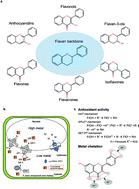当前位置:
X-MOL 学术
›
Metallomics
›
论文详情
Our official English website, www.x-mol.net, welcomes your
feedback! (Note: you will need to create a separate account there.)
Biomolecular approaches to understanding metal tolerance and hyperaccumulation in plants.
Metallomics ( IF 2.9 ) Pub Date : 2020-05-20 , DOI: 10.1039/d0mt00043d Massimiliano Corso 1 , Vanesa S García de la Torre 2
Metallomics ( IF 2.9 ) Pub Date : 2020-05-20 , DOI: 10.1039/d0mt00043d Massimiliano Corso 1 , Vanesa S García de la Torre 2
Affiliation

|
Trace metal elements are essential for plant growth but become toxic at high concentrations, while some non-essential elements, such as Cd and As, show toxicity even in traces. Thus, metal homeostasis is tightly regulated in plants. Plant species colonising metalliferous soils have evolved mechanisms to hypertolerate metals and, in rare cases, can hyperaccumulate them in excess amounts in their shoots. The molecular mechanisms of metal hypertolerance and hyperaccumulation are likely derived from alterations in the basic mechanisms involved in general metal homeostasis. Genes involved in metal transport, synthesis of metal chelators and oxidative stress responses are constitutively and highly expressed in metal hypertolerant and hyperaccumulator species. Plant specialized metabolites and cell wall components have been proposed as major players in these mechanisms. In addition, the high intra-specific natural variation of metal hypertolerance and hyperaccumulation suggests that various molecular mechanisms might be involved in the evolution of these traits. To date, the potential of wild plant populations as systems to study metal tolerance and hyperaccumulation has not been fully exploited. The advent of next-generation sequencing (NGS) has enabled the study of non-model species, providing an opportunity to study natural populations and new tolerant and/or hyperaccumulating species, and will provide new insights into metal tolerance and hyperaccumulation. In this review we highlight background knowledge about metal tolerance and hyperaccumulation in plants and the current state-of-the-art techniques to study and identify the underlying mechanisms of metal hypertolerance and hyperaccumulation. We also outline for the reader the importance of the multidisciplinarity of this research field and how the integration of multiomic approaches will benefit facing the future scientific challenges.
中文翻译:

了解植物中金属耐受性和超积累的生物分子方法。
微量金属元素对植物生长至关重要,但在高浓度时会产生毒性,而一些非必需元素,如 Cd 和 As,即使在痕量下也表现出毒性。因此,植物中的金属稳态受到严格调控。定居在含金属土壤中的植物物种已经进化出过度耐受金属的机制,并且在极少数情况下,可以在它们的枝条中过度积累金属。金属超耐受和超积累的分子机制可能源于一般金属稳态所涉及的基本机制的改变。参与金属运输、金属螯合剂合成和氧化应激反应的基因在金属超耐受和超积累物种中组成型和高度表达。植物特化代谢物和细胞壁成分已被提议作为这些机制的主要参与者。此外,金属超耐受和超积累的高种内自然变异表明,这些性状的进化可能涉及各种分子机制。迄今为止,野生植物种群作为研究金属耐受性和超积累的系统的潜力尚未得到充分利用。下一代测序 (NGS) 的出现使非模式物种的研究成为可能,为研究自然种群和新的耐受和/或超积累物种提供了机会,并将提供对金属耐受性和超积累的新见解。在这篇综述中,我们重点介绍了植物中金属耐受性和超积累的背景知识,以及目前研究和确定金属超耐受和超积累的潜在机制的最先进技术。我们还为读者概述了该研究领域多学科性的重要性,以及多组学方法的整合将如何受益于未来的科学挑战。
更新日期:2020-06-25
中文翻译:

了解植物中金属耐受性和超积累的生物分子方法。
微量金属元素对植物生长至关重要,但在高浓度时会产生毒性,而一些非必需元素,如 Cd 和 As,即使在痕量下也表现出毒性。因此,植物中的金属稳态受到严格调控。定居在含金属土壤中的植物物种已经进化出过度耐受金属的机制,并且在极少数情况下,可以在它们的枝条中过度积累金属。金属超耐受和超积累的分子机制可能源于一般金属稳态所涉及的基本机制的改变。参与金属运输、金属螯合剂合成和氧化应激反应的基因在金属超耐受和超积累物种中组成型和高度表达。植物特化代谢物和细胞壁成分已被提议作为这些机制的主要参与者。此外,金属超耐受和超积累的高种内自然变异表明,这些性状的进化可能涉及各种分子机制。迄今为止,野生植物种群作为研究金属耐受性和超积累的系统的潜力尚未得到充分利用。下一代测序 (NGS) 的出现使非模式物种的研究成为可能,为研究自然种群和新的耐受和/或超积累物种提供了机会,并将提供对金属耐受性和超积累的新见解。在这篇综述中,我们重点介绍了植物中金属耐受性和超积累的背景知识,以及目前研究和确定金属超耐受和超积累的潜在机制的最先进技术。我们还为读者概述了该研究领域多学科性的重要性,以及多组学方法的整合将如何受益于未来的科学挑战。









































 京公网安备 11010802027423号
京公网安备 11010802027423号